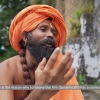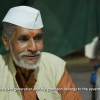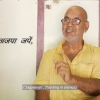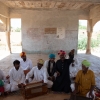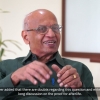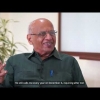A resident of Na Shyam Gaon in Jorhat district of Assam, he traces his lineage to Pangyuk, one of the nine original Khamyang leaders who came to present-day Assam. Dr Shyam has worked extensively to conserve indigenous Tai Khamyang knowledge and promote studies related to the Tai people and Buddhism. He has also overseen numerous research projects that focused on these topics.
Following is an edited transcript of the interview, translated from Assamese, conducted on September 2, 2018, in Titabor, Jorhat.
Chandrica Barua (CB): Where are the Tai Khamyangs originally from, and what is the history of their migration to present-day Assam?
Narendra Shyam (NS): The Khamyangs are originally from a place adjacent to two Burmese kindgoms, Mong-Mit and Mong-Kong; the place was called Khamyang; it is a Tai word. Kham means ‘gold’ and yang means ‘to have/to possess’. The word ‘Khamyang’ indicated that we lived in a place that had gold.
Please note that in Khamyang language, the consonant ‘y’ is not pronounced as y, rather it is pronounced as ‘j’. Thus, we Khamyangs should actually be called Khamjangs. Over time, the word has become Khamyang.
CB: Where was Khamyang located?
NS: It was somewhere in the mid-region of Southeast Asia. According to our buranji (historical chronicles), Sitou Tai Khamyang, the Khamyangs travelled to Assam because they were sent by the first Ahom ruler Sukaphaa’s elder brother to locate him. Chaolung/Sao Lung Sukaphaa had been banished from the Mong-Kong kingdom by his brother, who suspected him of engineering a coup. When the king realised he was mistaken, he sent some Tai groups (Aiton, Turung and Phake) in search of Sukaphaa. When they failed, the king chose to send the Khamyangs, whom he considered best for the job.
CB: Why did the king feel this way? Was there a history between Sukaphaa and the Khamyangs?
NS: Sukaphaa had lived for a couple of years with the Khamyangs at Khamyang, the place. Thus, the king felt that they would be able to reach him, as they knew him better.
Back then, the Khamyangs had an association of nine people, kao-hai, kao meaning nine and hai meaning association. They were Pangyuk, Tunkhang, Wailung, Thaomung, who are the Gohains now. Ahoms also have this title. Then there were Chaohai, Phalek, Chaosong, Chaolu and Chaolik. The nine members would hold leadership consecutively on each day of the nine-day week, and on the 10th, they would all be leaders. Kao-hai was sent to find Sukaphaa.
CB: Was the weekly calendar different back then?
NS: The Tai people followed a monthly calendar according to the changes of the moon, where 10 days made a week.
CB: You were telling us about the search mission. Did the Khamyangs manage to locate Sukaphaa?
NS: Yes, the Khamyangs met Sukaphaa in Abhaypur, located a short distance away from Sonari in present-day Assam. They delivered the news, and after staying for a few days, prepared to return to their homeland. Sukaphaa suggested that the Khamyangs could live in an area between his and his brother’s kingdom, as that would make it easier for the brothers to maintain communication. The Khamyangs returned and relayed the news and the suggestion to the king.
On their way to the king, they came across twin lakes, Nongjang and Nongkheu, near the Patkai Hills. They asked for the king’s permission to settle near the lakes. With the king’s permission, the Khamyangs started living in the lake area. They were there for almost 500 years.
From there they went to Arunachal Pradesh, and settled down in Khamgjangna in present-day Changlang district. Na means field, thus Khamjangna means ‘the fields of Khamjang’. They lived there for a couple of years. Then they went to Tengapani and Xadiya (Sadiya) in present-day Assam, where the Khamtis were already settled. After living there for a few years, they planned on going to Assam. Around 1780 AD, they left Mungtela and entered Assam during the reign of Gaurinath Singha. The Ahom kingdom was in a very bad state then. That was the time of the Moamoria rebellion, so the ministers asked them to return when the situation settled down.
From that time, the Khamyangs led a nomadic life for several years. After the rebellion, they went back to Assam, where they met the king. He gave them an area near Titabor. When the Burmese attacked Assam, the British came to expel the Burmese. According to 1826 Treaty of Yandaboo, Assam was annexed by the British. They started their project of opening tea gardens. The area where the Khamyangs were settled was ideal for tea estates, and the British introduced taxes in the area. Our people were cowardly, especially when it came to money and taxes. So, they left and settled in a village called Borgaon. Two years later, an epidemic wiped away 70 families. They immediately burnt down their houses, and travelled to a nearby place called Paninora. However, that was not permanent either.
After a few years, they travelled to present-day Na Shyam, Balijan and Betbari Shyam villages. This was around 1829.
CB: Could you also talk about the language and sociocultural life of the Khamyangs?
NS: Even though the Khamyang langauge is not functional today, 40 per cent of our day-to-day sociocultural and interpersonal activities include words from the language, especially when it comes to food. For example, words associated with food, social customs and clothes are all Tai words. The people of Powaimukh village still retain their language and culture. They can speak and read Khamyang perfectly.
We also use Pali language extensively. All our religious shlokas, prayers, rituals and traditions are in Pali. We have many Pali schools.
CB: Are the scripts and the languages the same for all Tai groups?
NS: No, the script is a little different. Our Khamyang script is different. The Ahom script is different. Tai Phake and Turung scripts are different as well, although Turung is mostly colloquial. We have Tai schools to recover the language now. If one cannot read Tai, we will never understand the true substance of the texts. So much gets lost in translation. If we had known Tai language, we could have understood the texts properly.
CB: You mentioned the nine-people association kao-hai. Are the current Khamyangs descendants of those nine?
NS: Yes, I am a descendent of Pangyuk. Most of the Chalapathar [in Sivasagar district] families are of Chaolu descent. The descendants of Chaosong and Phalek struggled with their identity for a long time. They had no names. We, from the Buranji Parishad, helped them reclaim their heritage and identity. Over time, many more families were created from the original nine.
CB: What is the position of women in your society?
NS: Tai Khamyang women share absolute equality with men. We do not have dowry system. Till today, we have not heard of daughters-in-law being oppressed due to dowry conflicts. No one can offer dowry and no one can receive it. It cannot be a social transaction at all. Our brides do not use vermillion. They are economically empowered. There are certain rituals that only women can perform. Men cannot do them without the presence of women.
CB: What are some of these rituals?
NS: Rituals connected to the delivery of a baby or when the baby is purified are carried out by women. The ceremony of cutting of the umbilical cord is performed by women; men have no place in it.
Our houses have two poles in its foundation which signify the male and the female—one pole which faces the east is called the phi-lam. We believe that the phi-lam harbours the souls of our ancestors.
There is another ceremony called ayux mota, to invite health. If someone is suffering from a long-term illness or is in shock, it is believed that their lifespan reduces. To reverse this, the women get together and perform certain rituals. That is the job of the women, men cannot do it.
The social occasions that are about children usually require the presence of women. We have this event where we introduce our children to axes and swords. I tell the people the reason our ancestors did this was that they used to roam around hunting and fighting. Thus, children had to learn how to use these tools. However, today we should also introduce them to pen and paper. Earlier, it was a different world but one cannot survive without education these days.
CB: You mentioned the foundation poles of your houses. Are these houses chang-ghors?
NS: Traditionally, we had chang-ghors. Now it is very expensive to construct them. We need a lot of wood and bamboo. So, while in villages we still have chang-ghors, in towns we now erect houses on the ground.
CB: Where did the surname Shyam come from? Were you always Shyams?
NS: We write Shyam now, but earlier we used to write Siam. Our surname came from the Shan of the Shan States.
CB: Is it also linked to the Siam state of olden times?
NS: Yes, that entire area was called Siam. Shyam is also derived from Siam.




